This article was co-authored by Robert Dhir, MD. Dr. Robert Dhir is a board certified Urologist, Urological Surgeon, and the Founder of HTX Urology in Houston, Texas. With over 10 years of experience, Dr. Dhir’s expertise includes minimally-invasive treatments for enlarged prostate (UroLift), kidney stone disease, surgical management of urological cancers, and men’s health (erectile dysfunction, low testosterone, and infertility). His practice has been named a Center of Excellence for the UroLift procedure, and is a pioneer in non-surgical procedures for ED using his patented Wave Therapy. He earned his undergraduate and medical degrees from Georgetown University and was awarded honors in pre-medical studies, urology, orthopedics, and ophthalmology. Dr. Dhir served as chief resident during his urological surgical residency at University of Texas at Houston / MD Anderson Cancer Center in addition to completing his internship in general surgery. Dr. Dhir was voted Top Doctor in Urology for 2018 to 2019, one of the top three Best Rated Urologists in 2019 & 2020 for Houston Texas, and Texas Monthly has named him to the 2019 & 2020 Texas Super Doctors Rising Stars list.
wikiHow marks an article as reader-approved once it receives enough positive feedback. In this case, 81% of readers who voted found the article helpful, earning it our reader-approved status.
This article has been viewed 232,535 times.
A urinary catheter, or Foley catheter, is a thin, flexible tube that allows your urine to drain directly from your bladder to a small bag outside your body. Removing a catheter is a fairly simple procedure. Most people have little difficulty removing a catheter themselves; however, if you experience any significant discomfort, remember to contact your health care provider immediately.
Things You Should Know
- Empty the urinary catheter bag so it's easier to remove.
- Wash your hands and wear gloves when removing the bag to prevent an infection.
- Lie down on your back with your knees bent and legs spread for the easiest removal.
Steps
Removing a Urinary Catheter
-
1Wash your hands with soap and warm water. Make sure you soap your hands and forearms well, and rub them together for at least 20 seconds. This is approximately the length of time it takes to sing the familiar song, "Happy Birthday to You" two times. Follow by rinsing well.[1]
- You'll follow the same routine of washing when you finish removing the catheter.
- Dry your hands well with a paper towel, and throw the towel away. This is a good opportunity to make sure that there's a trashcan nearby. You'll need the trashcan for disposing of your catheter.
-
2Empty the urinary catheter bag of urine for easier catheter removal.[2] Your bag may have a drain spout that you remove from its sleeve, a clamp that you open to the side, or an opening that you twist. Drain any urine in the bag into a toilet bowl. You may also use a measuring container if your medical provider is keeping track of your output.
- When the bag is empty, close the clamp or twist the cap on the bag. This will prevent dripping.
- If your urine is cloudy, foul-smelling, or if you notice any sign of red, contact your health care provider.
Advertisement -
3Get into a comfortable position for removing the catheter. You'll need to be uncovered from the waist down. The best position to be in when removing a catheter is to lie on your back with your legs spread and your knees bent, feet flat on the floor.
- You can also lay in a butterfly position. Lie down and spread your knees apart while keep your feet together.
- Lying on your back will also relax your urethra and bladder, making it easier to remove the catheter.
-
4Put gloves on and clean the drainage tubing. It is important to wear gloves so that you lower your risk of getting any infection. Once the gloves are on, use an alcohol wipe to clean the connection spot where the drainage tube connects to the catheter. You should also clean around the catheter.[3]
- If you are a man, use a saline (saltwater) solution to clean the urethral opening on the penis.
- If you are a woman, use a saline solution to clean around the labia and urethral opening. Clean by starting at the urethra and then moving outward to avoid any spread of bacteria.
-
5Identify the balloon port of your catheter. The tubing of the catheter will have two ports. One port empties urine into the urinary bag. The other allows you to drain the small water-filled balloon that holds the catheter inside your bladder.
- The balloon valve should have a colored valve on the end.
- You may also see numbers printed on the balloon valve.
-
6Deflate the catheter balloon. The small balloon inside your bladder will need to be drained, or deflated, in order to remove the catheter. Your medical provider should have provided you with a small (10 ml) syringe.[4] This syringe should fit precisely into the balloon port. Insert with a firm push-and-twist motion.
- Slowly and carefully, pull the syringe away from the port. The vacuum effect will pull water from the balloon in the bladder.
- Continue until the syringe is full. This should indicate that the balloon is empty, and ready for removal.
- Do not pump any air or liquid back into the balloon as it could burst and injure your bladder.
- Always make sure the amount of fluid withdrawn from the balloon port matches the amount of fluid infused prior to attempting removal. If you are unable to withdraw the appropriate amount of fluid seek professional assistance.
-
7Remove the catheter. If possible, clamp the catheter tube with artery forceps or a rubber band to keep any urine from flowing out of the catheter while you remove it. Then, gently pull the catheter out of the urethra. It should come out easily.[5]
- If you feel any resistance, it means that there is most likely still water in the balloon. If this is the case, you will need to put a syringe back into the balloon port and take out any extra water like you did in the previous step.
- Men may feel a stinging sensation as the balloon travels down the urethra. This is a normal experience, and not a cause for concern.
-
8Inspect the catheter to make sure it's intact. If it seems to have broken or cracked, there may be pieces left inside. If this is the case, contact your medical provider immediately.[6]
- If this is the case, do not throw the catheter away. Keep it for your medical provider to examine.
- These syringes are not considered to be contaminated with biological waste because no bodily fluids are present in this line unless the balloon has burst. These syringes can be disposed of through normal means in a secure, hard plastic container with a lid.
-
9Throw away the used catheter and urine bag. Once you have removed the catheter, place it into a plastic bag. Seal the bag, then put the sealed bag with your other household trash.
- Clean up the area where the catheter had been inserted with a saline solution. If there is any sign of pus or blood, contact your health care provider immediately.
- Remove your gloves and wash your hands once you are done.
- For a pain-relieving effect, you can apply some lidocaine jelly to the area around your urethra.
Making Sure You're Healthy After Catheter Removal
-
1Check for signs of inflammation or infection. Signs of infection include reddening, swelling, or pus around the area where catheter had been removed. Fever may also indicate the presence of infection.
- Continue to flush the area with warm, salty water. Bathe and wash as usual. While you may have discontinued baths when your catheter was inserted, showers are fine. Now that you've removed the catheter, you can take baths as well.
- Your urine should be clear or light yellow. Presence of light pink urine is also normal for the first 24 – 48 hours following catheter removal, as a slight amount of blood may have entered the urinary tract. Urine that is dark red in color is a sign of blood, and foul-smelling or cloudy urine may indicate infection. If either of these are present, contact your medical provider immediately.
- You may experience a slight rash on the area where your catheter has been removed. Cotton underwear allows for freer airflow to the area which aids healing.
-
2Keep track of the time when you go to the bathroom. After removing a catheter, it's important to keep track of your urination patterns. If you have not urinated within eight hours of removing your catheter, contact your health care provider.
- It's normal for urination to become a little irregular once your catheter is removed. It's common to find yourself needing to urinate more frequently than normal.
- You may experience a slight discomfort when urinating. If this persists beyond 24 – 48 hours following catheter removal, this may indicate infection.
- You may also find that you have difficulty controlling your urine flow. This is not unusual. Keep track of incidents that concern you, and ask your medical provider about these incidents at your next visit.
- Keep a urination diary to help your doctor determine whether or not any further steps are needed on the path to your recovery.
-
3Drink plenty of fluids. Drinking six to eight cups per day of water will help aid recovery of your urinary tract. Drinking a lot of water can help to increase your urine volume while also flushing out any bacteria or microorganisms in your bladder and urethra.
- Avoid drinking caffeine as it may irritate the bladder.[7]
- Limit your fluid intake after 6:00 pm. Drinking too much liquid in the evening may wake you up during the night.
- Elevate your feet when seated, particularly in the evening.
Knowing Why a Catheter is Removed
-
1Remove a catheter permanently after its use has come to an end. Urinary catheters are inserted temporarily following many surgical procedures. Once you have recovered from the surgery, or the obstruction has been removed, you don’t need the catheter anymore.
- For example, if you have prostate surgery, you will generally receive a catheter that can be taken out 10 to 14 days after surgery.
- Follow your medical provider's post-surgical guidelines and recommendations. These will be individualized to your health care situation.
-
2Change your catheter regularly if you need your catheter for a long period of time. Your catheter will only need to be replaced if you cannot independently empty your bladder. People who get a catheter because they have a chronic illness or incontinence (a condition where you have a problem holding urine inside) that has been caused by an injury may need to have a catheter for a long period of time.
- For example, if you suffered a spinal cord injury that has caused you to develop incontinence, you will need to have a catheter in place for a long period of time. Replace your catheter with a fresh one every 14 days or as directed by manufacturer or physician recommendations.
-
3Remove your catheter if you start having unwanted side effects. Some people experience complications when they get a catheter. One of the most common negative side effects is developing a urinary tract infection. If you see any pus near your urethra, or have cloudy, bloody, or foul-smelling urine, you may have a urinary tract infection. Your catheter will have to be removed and you should talk to your doctor about treating your tract infection.
- You may also notice a large amount of urine coming out from around the catheter. If you do notice this, remove the catheter. It is most likely defective.
- If there is no urine draining into the catheter, there may be an obstruction in the device. If this is the case, it needs to be removed immediately and you should go to the doctor right away. Do not irrigate your catheter without first consulting a healthcare professional.[8]
Expert Q&A
Did you know you can get expert answers for this article?
Unlock expert answers by supporting wikiHow
-
QuestionIf I can't withdraw the water. What can I do?
 Timothy Sherman, RNTimothy Sherman is a Registered Nurse (RN) based in Austin, Texas and affiliated with St. David's HealthCare. With over seven years of nursing experience, Timothy specializes in working with adults in a general medical/surgical setting, chemotherapy, and with biotherapy administration. He has also instructed Essentials of Medical Terminology and Anatomy and Physiology for Medical Assistants at Austin Community College. He received his BS in Nursing from Wichita State University in 2012.
Timothy Sherman, RNTimothy Sherman is a Registered Nurse (RN) based in Austin, Texas and affiliated with St. David's HealthCare. With over seven years of nursing experience, Timothy specializes in working with adults in a general medical/surgical setting, chemotherapy, and with biotherapy administration. He has also instructed Essentials of Medical Terminology and Anatomy and Physiology for Medical Assistants at Austin Community College. He received his BS in Nursing from Wichita State University in 2012.
Registered Nurse
-
QuestionWhat could cause pain while inserting the catheter as well infrequent painful urination?
 Timothy Sherman, RNTimothy Sherman is a Registered Nurse (RN) based in Austin, Texas and affiliated with St. David's HealthCare. With over seven years of nursing experience, Timothy specializes in working with adults in a general medical/surgical setting, chemotherapy, and with biotherapy administration. He has also instructed Essentials of Medical Terminology and Anatomy and Physiology for Medical Assistants at Austin Community College. He received his BS in Nursing from Wichita State University in 2012.
Timothy Sherman, RNTimothy Sherman is a Registered Nurse (RN) based in Austin, Texas and affiliated with St. David's HealthCare. With over seven years of nursing experience, Timothy specializes in working with adults in a general medical/surgical setting, chemotherapy, and with biotherapy administration. He has also instructed Essentials of Medical Terminology and Anatomy and Physiology for Medical Assistants at Austin Community College. He received his BS in Nursing from Wichita State University in 2012.
Registered Nurse Pain is normal with catheter insertion but if you are having increased pain different from previous insertions it may be due to local irritation or trauma. With a catheter inserted you should not need to urinate, or force urine out. Pain following catheter removal is normal until local irritation resolves. Infrequent urination can be the result of a concerning complication from an infection or mediation or it could be part of the normal recovery process following catheter removal. Provide your healthcare provider with detailed information regarding your signs and symptoms.
Pain is normal with catheter insertion but if you are having increased pain different from previous insertions it may be due to local irritation or trauma. With a catheter inserted you should not need to urinate, or force urine out. Pain following catheter removal is normal until local irritation resolves. Infrequent urination can be the result of a concerning complication from an infection or mediation or it could be part of the normal recovery process following catheter removal. Provide your healthcare provider with detailed information regarding your signs and symptoms. -
QuestionIs it normal to see some blood and clots in the Foley bag?
 Timothy Sherman, RNTimothy Sherman is a Registered Nurse (RN) based in Austin, Texas and affiliated with St. David's HealthCare. With over seven years of nursing experience, Timothy specializes in working with adults in a general medical/surgical setting, chemotherapy, and with biotherapy administration. He has also instructed Essentials of Medical Terminology and Anatomy and Physiology for Medical Assistants at Austin Community College. He received his BS in Nursing from Wichita State University in 2012.
Timothy Sherman, RNTimothy Sherman is a Registered Nurse (RN) based in Austin, Texas and affiliated with St. David's HealthCare. With over seven years of nursing experience, Timothy specializes in working with adults in a general medical/surgical setting, chemotherapy, and with biotherapy administration. He has also instructed Essentials of Medical Terminology and Anatomy and Physiology for Medical Assistants at Austin Community College. He received his BS in Nursing from Wichita State University in 2012.
Registered Nurse Following some surgical procedures this is a normal finding. If blood clots are present in the foley bag seek medical attention. Blood clots can obstruct catheter flow and increase your risk for infection. Do not irrigate your catheter yourself at home. This is best done in a clean setting by a professional.
Following some surgical procedures this is a normal finding. If blood clots are present in the foley bag seek medical attention. Blood clots can obstruct catheter flow and increase your risk for infection. Do not irrigate your catheter yourself at home. This is best done in a clean setting by a professional.
Warnings
- If you have a central venous catheter or a peripheral venous catheter, it must only be removed by a trained physician. Attempting to remove these types of catheters yourself could have extremely dangerous results.⧼thumbs_response⧽
- Go to the emergency room at your local hospital or urgent care provider if you notice any of the following signs: You feel as if you need to urinate but can’t. If you have severe back pain, or abdominal swelling. If you have a fever of 100.1°F (38°C) degrees or more. If you experience nausea and vomiting.⧼thumbs_response⧽
- Lubricant should not be used when removing catheters. Increases risk for urinary tract infections by promoting the transfer of bacteria from the skin into the urethra to lubricate distal catheter.⧼thumbs_response⧽
References
- ↑ http://www.cdc.gov/handwashing/when-how-handwashing.html
- ↑ Robert Dhir, MD. Board Certified Urologist & Urological Surgeon. Expert Interview. 23 September 2020.
- ↑ https://www.nursingtimes.net/clinical-archive/continence/urinary-catheters-4-removing-an-indwelling-urinary-catheter-21-10-2008/
- ↑ Robert Dhir, MD. Board Certified Urologist & Urological Surgeon. Expert Interview. 23 September 2020.
- ↑ http://www.nlm.nih.gov/medlineplus/ency/article/003981.htm
- ↑ http://www.brooksidepress.org/Products/Nursing_Fundamentals_II/lesson_3_Section_1A.htm
- ↑ https://medlineplus.gov/ency/article/000483.htm
- ↑ Robert Dhir, MD. Board Certified Urologist & Urological Surgeon. Expert Interview. 23 September 2020.
About This Article
A urinary catheter is a thin flexible tube that allows urine to drain from your bladder into a small external bag. Catheters are fairly easy to remove yourself, but if you experience any significant pain, call your doctor for help. Before you remove it, wash your hands and empty the catheter bag. Then, lie down in a comfortable position and use an alcohol wipe to gently clean your urethral opening where the catheter connects to the drainage tube. This will lower your risk of infection. Once it’s clean, insert the syringe your doctor provided you into the balloon port, which is the valve with a colored end. Then, slowly and carefully pull the syringe away to drain the water from the balloon. Clamp the catheter tube with a rubber band to stop the urine from flowing, then gently pull the catheter out of your urethra. After you remove the catheter, inspect it to make sure it’s intact. If not, go to the doctor as soon as possible so they can remove the missing parts. For advice on how to stay healthy after using a catheter, read more from our Medical co-author!
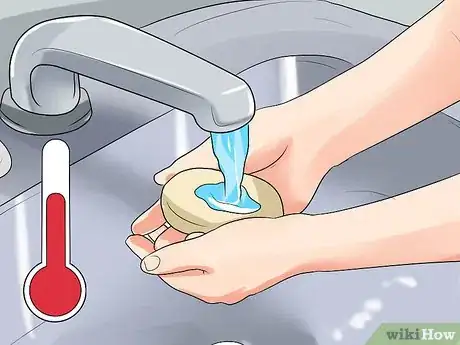


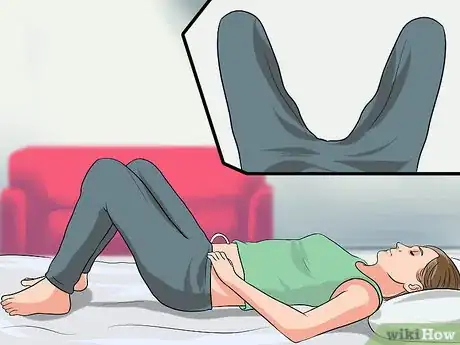
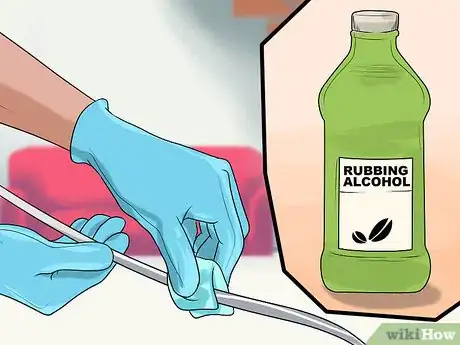
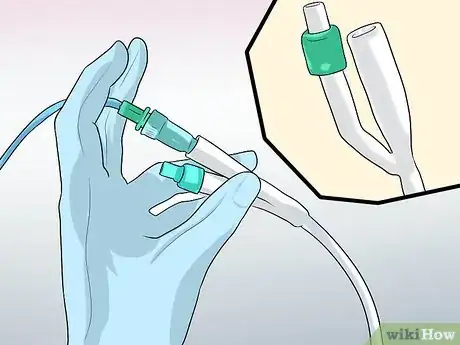
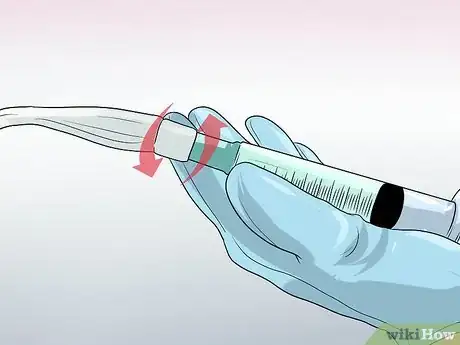
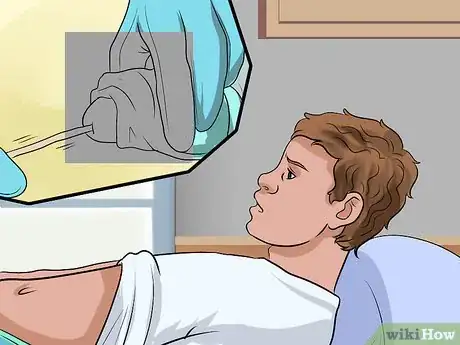

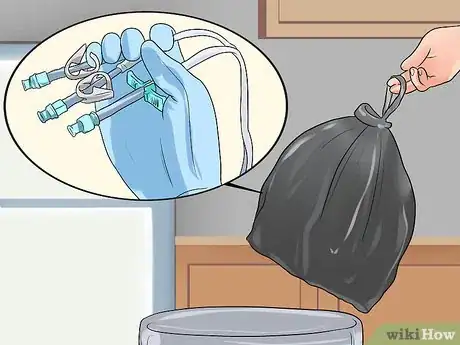



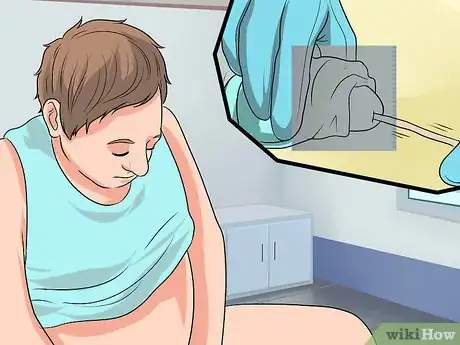

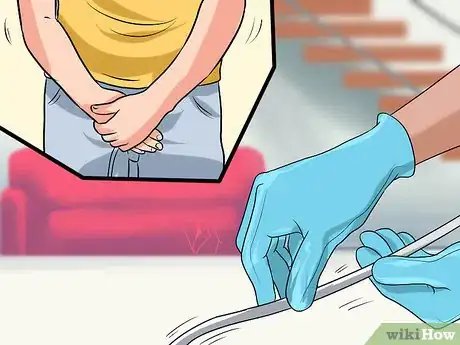




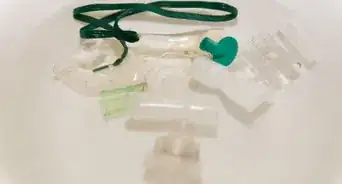
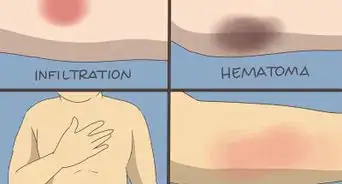

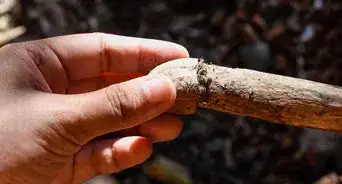

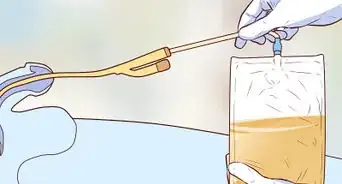
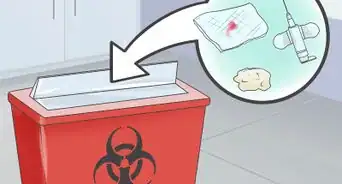











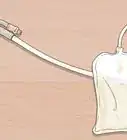
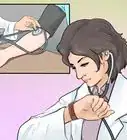




































Medical Disclaimer
The content of this article is not intended to be a substitute for professional medical advice, examination, diagnosis, or treatment. You should always contact your doctor or other qualified healthcare professional before starting, changing, or stopping any kind of health treatment.
Read More...